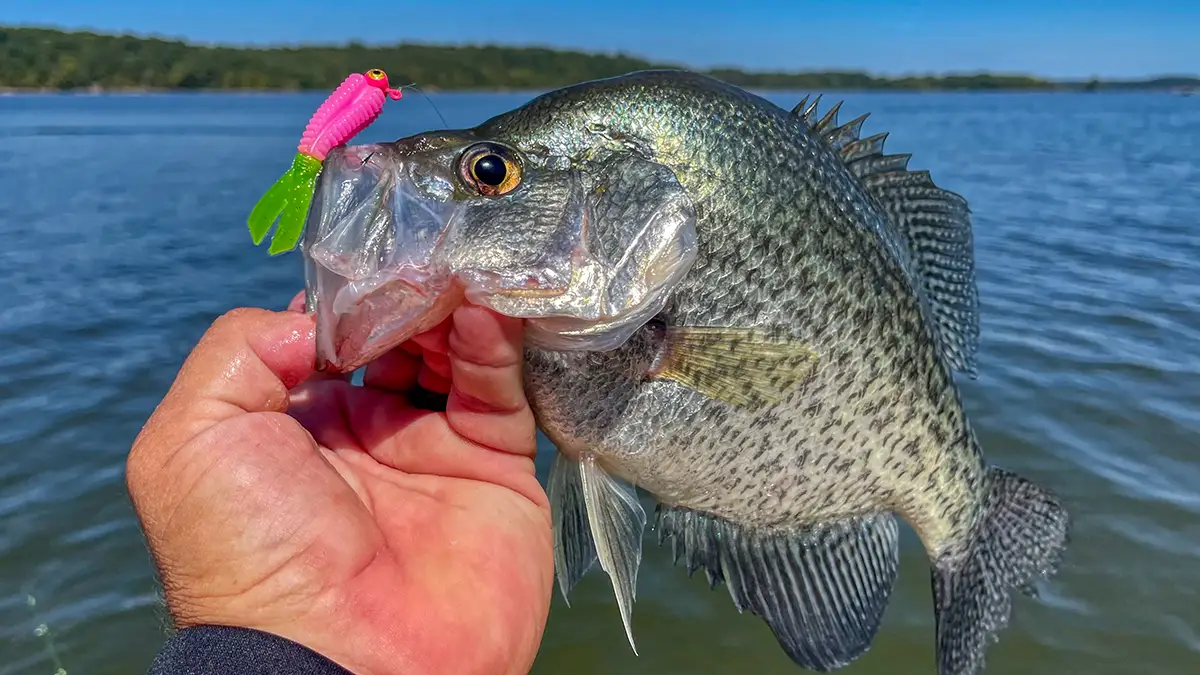To go crappie fishing, here are some steps to follow:
1. Equipment and Gear:
– Get a crappie fishing rod and reel combo with a sensitive tip.
– Choose lightweight fishing line, preferably 4-8 pounds test line.
– Select crappie hooks, sized between #4 and #8.
– Use small bobbers and split shots for the rig setup.
– Have a small tackle box filled with crappie jigs, live minnows, and artificial bait.
2. Find Crappie:
– Look for crappie in shallow waters during spring spawning season.
– Search for submerged structures like fallen trees, weed beds, or brush piles where crappie hide.
– Use a fishfinder to locate schools of crappie if fishing in a larger body of water.
3. Bait Selection:
– Live Minnows: Hook a live minnow through its back, just behind the dorsal fin. Drop it near the structures or where you locate crappie on your fishfinder.
– Artificial Bait: Use brightly colored crappie jigs or soft plastic baits. Attach them to your jig head and gently retrieve it, imitating the movement of small baitfish.
4. Rig Setup:
– Attach your chosen hook to the fishing line.
– Slide a small split shot weight onto the line, about 8-10 inches above the hook.
– Attach a small bobber above the split shot to detect bites.
5. Technique:
– Cast your bait near the structures or where you spotted crappie.
– For live minnows, let it move naturally and wait for the bobber to go under.
– For artificial bait, retrieve it slowly and vary the speed until you find what works best.
– When you feel a bite or see the bobber dip, set the hook by giving a firm but controlled upward motion of the rod.
6. Safety and Regulations:
– Check local fishing regulations and make sure you have the required fishing license.
– Wear appropriate safety gear, including a life jacket if fishing from a boat.
– Be cautious of weather conditions and follow boating safety guidelines if fishing from a boat.
Remember, crappie tend to be more active during dawn and dusk, so plan your fishing trip accordingly. Catch and release any undersized crappie to help sustain the population and promote a healthy ecosystem.
Know More About: how to crappie fish
Crappie Fishing: Tips and Techniques for a Successful Catch
Introduction:
Crappie fishing, also known as speckled perch or papermouth fishing, is a popular pursuit among anglers. These small yet delicious freshwater fish can offer an exciting fishing experience for both beginners and seasoned fishermen alike. In this article, we will explore some valuable tips and techniques that can help increase your chances of a successful crappie fishing trip.
Choosing the Right Equipment:
When it comes to crappie fishing, the right equipment can make all the difference. Opting for a lightweight spinning rod and reel combo is a great choice for targeting these small fish. Ensure that your reel is spooled with four to eight-pound test monofilament line, which provides adequate strength to handle crappie while also maintaining sensitivity for detecting subtle bites.
Finding the Ideal Location:
Crappie tend to gather around submerged structures, such as fallen trees, brush piles, docks, or weed beds. Exploring the lake or river you intend to fish and identifying these prime spots is crucial for a successful outing. Utilize fish finders or depth finders to locate structures and drop-offs, as crappie often suspend at different depths depending on the temperature and time of day.
Mastering the Art of Crappie Baits:
There are various types of baits that can prove effective for crappie fishing. Live minnows, small jigs, and soft plastic baits are widely used and can be employed in different ways to entice the fish. When using live bait, hook the minnow through the lips or just behind the dorsal fin. For artificial jigs, experiment with different colors and sizes to find what works best during your fishing session.
Casting and Retrieving Techniques:
An essential aspect of crappie fishing is the presentation of your bait. When casting, aim for areas near submerged structures or weed beds where crappie are likely to hide. Allow the bait to sink to the desired depth before slowly retrieving it with gentle twitches or a slow steady retrieve. This mimics the natural movement of baitfish and lures the crappie to strike.
Understanding Seasonal Patterns:
Crappie behavior can vary greatly depending on the time of year. During the spring spawning season, crappie move towards shallow waters to reproduce, making it an ideal time for fishing. In summer, they tend to move towards deeper, cooler waters, often suspending at specific depths. Fall can be a productive season as crappie feed heavily before winter, while in winter, they become less active and tend to gather in deep holes.
Patience and Persistence:
Crappie fishing requires patience, as bites can be subtle and challenging to detect. Using a sensitive rod and paying close attention for any slight twitches or changes in line tension is crucial. When you get a bite, avoid immediately jerking the rod as this can cause the fish to spit out the bait. Instead, reel in the slack and set the hook with a gentle upward motion to secure the catch.
Environmental Considerations:
Lastly, it’s essential to be a responsible angler by adhering to local fishing regulations and practices. Respect the environment by properly disposing of any fishing gear and not leaving any trash behind. Furthermore, consider practicing catch-and-release to preserve the crappie population for future generations.
Conclusion:
Crappie fishing is an enjoyable and rewarding activity that offers anglers an opportunity to test their skill and enjoy a delicious meal. By equipping yourself with the right gear, locating prime fishing spots, mastering various fishing techniques, and understanding the fish’s behavior, you can significantly increase your chances of success on your next crappie fishing adventure. So, grab your rod, bait, and tackle box, and get ready to reel in some impressive crappie!
FAQs on how to crappie fish
1. What is crappie fishing?
Crappie fishing refers to the activity of angling specifically for crappie, a popular freshwater fish known for its delicious taste and challenging catch.
2. What are some common techniques used for crappie fishing?
Some common techniques for crappie fishing include using jigs, live bait, or artificial lures. Additionally, trolling, vertical jigging, and spider rigging are often employed to increase your chances of success.
3. What is the best time of year to go crappie fishing?
Spring and fall are typically considered the best times of the year for crappie fishing, as the fish tend to be more active during these seasons. However, they can be caught year-round in suitable water conditions.
4. What equipment do I need for crappie fishing?
You will need a fishing rod and reel suitable for freshwater fishing, as well as appropriate fishing line, hooks, and weights. A tackle box stocked with crappie jigs, live bait, or artificial lures, along with a landing net, is also essential.
5. Where can I find crappie fish?
Crappie can be found in both natural and man-made bodies of water such as lakes, reservoirs, ponds, and rivers. They tend to be attracted to submerged structures, such as fallen trees, docks, or brush piles, where they can hide and ambush their prey.
6. What is the best technique for catching crappie from a boat?
Spider rigging is a popular technique when fishing from a boat. It involves deploying multiple fishing rods, often with live bait, at various distances and angles, to increase your chances of locating and catching crappie.
7. Are there any specific guidelines for crappie fishing limits and regulations?
Yes, it is important to familiarize yourself with the local fishing regulations, as crappie fishing limits can vary by location and season. Make sure to adhere to size, bag, and possession limits to ensure the sustainability of the fish population.
8. What are some effective bait options for crappie fishing?
Live bait such as minnows, nightcrawlers, or crappie nibbles are popular choices for crappie fishing. Additionally, artificial lures like soft plastics, tube jigs, or crankbaits can also be successful in attracting these fish.
9. How do I locate schools of crappie fish?
Using a fishfinder or sonar device can greatly assist in locating schools of crappie. Look for areas with submerged structures, drop-offs, or underwater vegetation where these fish tend to congregate.
10. Any recommendations for beginner crappie fishermen?
Start by learning the basics of knot tying, casting, and rigging. Practice patience and persistence, as crappie can sometimes be finicky. Experiment with different techniques, locations, and bait until you find what works best for you. Consider joining a local fishing club or seeking advice from experienced anglers to enhance your skills.

